Engineering assessments in support of pipeline safety: Emerging trends and approaches—Part 1
Engineering assessments will increasingly be applied in the pipeline industry to demonstrate related fitness-for-service and appropriate safety margins to stakeholders, including industry, regulatory agencies and the public.
From a U.S. perspective, driving factors include the release of Part 1 of the Pipeline and Hazardous Materials Safety Administration’s (PHMSA’s) Gas Mega Rulea in October of 2019 (effective July 1, 2020), along with pending rulemaking on class location designation changes (this proposed rule would add an alternative set of requirements that operators could use, based on implementing integrity management principles and pipe eligibility criteria, to manage certain pipeline segments where the class location has changed from a Class 1 location to a Class 3 location); and Part 2 of the Gas Mega Rule, which focuses on repair requirements for high-consequence areas (HCAs) and non-HCAs. In lieu of replacing or re-testing pipelines, operators have the option of applying engineering critical assessments and advanced fitness-for-service solutions for validating and reconfirming maximum allowable operating pressure (MAOP), supporting special permitting for class location changes, and varying from prescriptive response and repair requirements.
From a Canadian perspective, operators will continue to be guided by the Canadian Standards Association (CSA) Z662 requirements to apply engineering assessments for demonstrating safe pipeline operations. The application of risk acceptance criteria, such as those proposed for the CSA Z662:23 standard1 or those considered in PHMSA’s “Paper study on risk tolerance,”2 will support a strategic framework for improving pipeline safety and the use of risk assessment results (i.e., in comparison to acceptable risk thresholds) within an engineering assessment.
Compliance is only part of the picture, as changes in corporate governance and public expectations demand improved safety and reliability. Without advanced engineering assessments, compliance efforts may lead to the replacement of pipe that is otherwise fit-for-service, resulting in missed opportunities to truly improve pipeline reliability and safety.
This article presents an overview of driving factors and trends for engineering assessments and code-related considerations. Practical data integration, approaches and application strategies, as well as a framework for developing and applying effective engineering assessments are provided. Approaches for integrating the data collected from continuously improving inline inspection (ILI) technologies into the engineering assessments are demonstrated.
Key factors. The increased application of robust engineering assessments and fitness-for-service evaluations is expected to play out in several key ways, such as:
- Increasing pipeline safety and reliability performance: This boils down to achieving the next level of safety through focused engineering work, along with the development and application of technology, to enhance data gathering and integration, assessment techniques and the associated workflows.
- Addressing the new and emerging regulatory landscape designed to help achieve improved safety and reliability performance: Without the insight and analyses from engineering assessments, compliance may result in pipe replacement, pressure reductions and pressure testing (and other material actions) on pipe that is otherwise fit-for-service.
- Engineering assessments provide an effective performance-based pathway forward: Detailed engineering and fitness-for-service evaluations will provide the best pathways forward to obtain the greatest yield from resources in terms of increasing pipeline safety and reliability and providing the biggest return on investment.
This article is focused on the following key topic areas as they pertain to engineering assessments and engineering critical assessments:
- Driving factors and trends
- Code-related considerations
- Data integration
- Framework strategies
- Application.
Background. It is important to start out by reviewing definitions related to engineering assessments and engineering critical assessments. There are also some interesting differences worth mentioning in how these are considered in the CSA standard vs. in the U.S. Code of Federal Regulations (CFR).
The engineering assessment and the engineering critical assessment are both defined in the CSA Z662 standard. The CSA Z662 definitions distinguish engineering assessments and engineering critical assessments from each other:
- Engineering assessment: A documented assessment of the effect of relevant variables upon fitness for service or integrity of a pipeline system, using engineering principles, conducted by or under the direct supervision of a competent person with demonstrated understanding and experience in the application of engineering and risk management principles related to the issues being assessed.1 In the Canadian standard, an engineering assessment applies to demonstrating fitness-for-service in a variety of circumstances.
- Engineering critical assessment: An analytical procedure, based on fracture mechanics principles, that allows determination of the maximum tolerable sizes for imperfections in fusion welds.1 In the Canadian standard, an engineering critical assessment applies specifically to the consideration of imperfections in girth welds after construction. Guidance on the application of engineering critical assessments to girth welds is provided in Annex J of the standard.
The U.S. codes do not specifically define the term engineering assessment; however, engineering critical assessment is defined in 49 CFR Part 192.3 (referenced in Subpart L, sections 192.624 and 192.632)3 as part of the Gas Mega Rule and new MAOP reconfirmation requirements:
- Engineering critical assessment: A documented analytical procedure based on fracture mechanics principles, relevant material properties (mechanical and fracture resistance properties), operating history, operational environment, in-service degradation, possible failure mechanisms, initial and final defect sizes, and usage of future operating and maintenance procedures to determine the maximum tolerable sizes for imperfections based upon the pipeline segment maximum allowable operating pressure.3 In the U.S. code, an engineering critical assessment is not specific to flaws in girth welds and has a broader fitness-for-service intent across various threat and defect types that overlaps with that of engineering assessments in the Canadian standard.
In summary, whether we are talking about the CSA’s engineering assessment or the U.S. CFR engineering critical assessment, these are both detailed fitness-for-service assessments that can consider various threats and defect types. This article focuses on these types of assessments, in the context of thorough fitness-for-service assessments specific to the circumstance at hand, and they will generally be referred to as engineering assessments in this article.
The circumstances for, and the use of, engineering assessments (Canada) and engineering critical assessments (U.S.) are converging in Canada and the U.S., including, but not limited to, the following:
- Class location designation changes
- Licensed MOP for Canada, approved MAOP for U.S. or MAOP upgrades
- Defect assessments or evaluations of damage
- Flow reversal or change in service
- Reactivating or repurposing a pipeline
- Pressure testing an existing pipeline
- Valve location and spacing
- MAOP validation and reconfirmation (U.S.)
- Special permits (U.S.)
- Governance (safety and reliability case management)
- Return to service after failure or outage.
Class location designation changes are expected to continue to be a key driver for engineering assessments and engineering critical assessments in both Canada and the U.S., respectively. The industry is spending hundreds of millions of dollars every year on pipe replacements where the existing pipe does not align with design requirements for the new class location designation.
CSA Z662 Clause 10.7.2 requires a conformance check of five key elements (mainly design related) for pipe in a class location designation change area. This includes the design factor or location factor, valve spacing, depth of cover, pressure testing and evaluation, and repair of imperfections. While provisions exist for engineering assessments to be carried out if one or more of the five elements cannot be met, it is acknowledged that deviations from design-based elements can create a challenge for gaining stakeholder approval and can result in replacement or pressure reduction actions that are not necessarily performance based or that can measurably improve pipeline reliability and safety.
Similarly, in the U.S., current approaches to evaluate a pipeline’s fitness-for-service in class location designation change circumstances are very arduous via the special permitting process [or potentially, in the future, through the current Notice of Proposed Rulemaking (NPRM) related to class location change requirements].
Reconfirmation of MAOP has the potential for creating billions of dollars of effort/impact if the industry must rely on replacements, pressure reductions and pressure tests for compliance. Engineering assessment methodology or other technology solutions can provide an alternative pathway forward when there is sound technical evidence that the pipe is otherwise fit-for-service. There are some cases where pipe replacement is required, but the engineering assessment should support this.
Driving factors and trends. There is a universal mandate from corporate governance structures, new and emerging regulations, and the public to increase pipeline safety and reliability performance. The success of these efforts is critical to maintain the industry’s social license to operate. It is important to note that the industry has made great strides in improving pipeline safety and reliability performance through compliance with integrity management, operational and maintenance regulations, and the application of initiatives to move beyond compliance only. Although the industry, regulatory community and public have been diligently working to determine how best to increase pipeline safety performance, all stakeholders acknowledge that the next level of performance will not be easy to accomplish from technical, operational and commercial perspectives.
Without the insight and analyses from engineering assessments in application with improved technology for enhanced data gathering/integration and assessment, compliance may result in pipe replacements, pressure reductions, pressure testing and other material actions on pipe that is otherwise fit-for-service. These massive resource allocations can be otherwise directed more effectively toward mitigating priority safety and reliability risks.
The U.S. regulatory structure continues to go through significant changes that will facilitate gaining the next level of pipeline safety and reliability performance. Part 1 of the Gas Mega Rule contains changes to the regulations for gas transmission pipelines, along with new requirements for the verification of pipeline materials. This part of the rule aims to improve safety with the transportation and operation of onshore gas transmission pipelines. Operators will be required to reconfirm the MAOP of their pipelines to ensure their safety, including pipelines that had been exempted from previous safety rulings. Part 2 of the Gas Mega Rule contains new repair requirements for HCAs and non-HCAs. Similar rulemakings have been made or are underway in the U.S. for liquids pipelines, gathering pipelines and gas storage facilities.
Presented as a forward-looking case study, an anticipated generational transformation driven by the Gas Mega Rule and NPRM activities is outlined as a phase diagram in FIG. 1 for the approximately 300,000 mi of U.S. gas transmission pipelines. Looking at the y-axis, integrity management has largely been focused on approximately 20,000 mi of pipelines in HCAs, with that focus largely based on inspection-based maintenance as illustrated moving along the x-axis. The other 280,000 mi have been managed via design, construction, and operating and maintenance considerations, recognizing that many operators have moved beyond this. Going forward, the HCA miles will begin the journey in transforming from inspection-based maintenance to performance-based integrity management. Pipelines in Class Location Designation 3 or 4, moderate consequence areas, and, most likely, most of the remainder of pipelines will enter inspection-based maintenance and advanced fitness-for-service approaches.
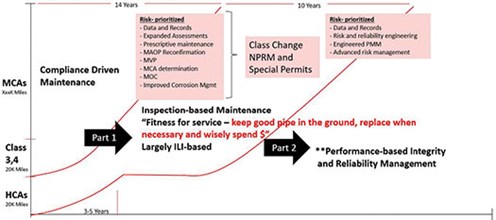 |
| FIG. 1. Pipeline integrity transformation driven by the Gas Mega Rule and NPRM. |
Although it has some limitations, the Gas Mega Rule has provided a strategic framework for improving pipeline safety and the use of engineering assessments, represented by the center portion of the phase diagram.
Detailed engineering and fitness-for-service evaluations will provide the best pathway forward to obtain the greatest yield from resources in terms of increasing pipeline safety and reliability and providing the largest return on investment. As outlined in FIG. 2, consistent and repeatable approaches (technical building blocks and programs) that can easily integrate and aggregate into solutions for more complex compliance and technical circumstances will serve to best support this pathway. On the left of the figure are some primary and specific conditions and threats that must be addressed. In the middle of the figure is where the technical building blocks are improved or developed. The far right of the figure shows the programs that will be constituted by a logical and pertinent arrangement of the technical building blocks to best achieve compliance and, most importantly, improve safety and reliability performance. These programs will be composed of consistent and repeatable workflows.
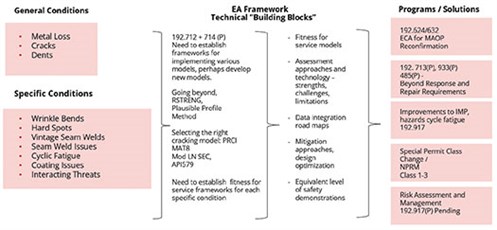 |
| FIG. 2. Engineering assessment technical building blocks for effective solutions. |
Supporting the technical building blocks and pathway toward effectively demonstrating safe and reliable pipeline operations is a well-structured engineering assessment approach and document design that provides reviewing stakeholders with a logical flow of technical analysis in support of the engineering assessment conclusions as outlined in the basic example in FIG. 3.
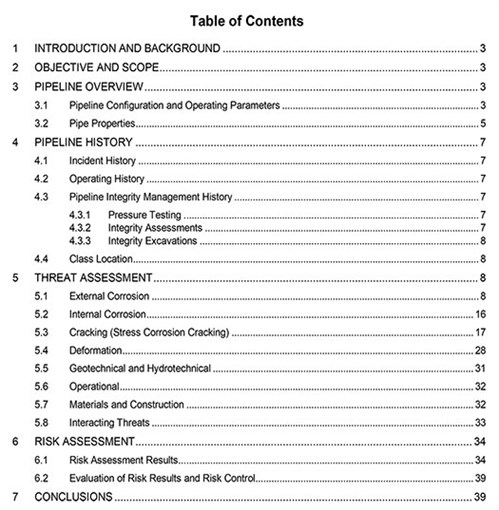 |
| FIG. 3. Example of engineering assessment document structure. |
Code-related considerations. In the Canadian standard, the requirements for engineering assessments are provided in clauses 3.4 and 10.1 of CSA Z662. Clause 3.4 establishes the structural requirements for the engineering assessment, while Clause 10.1 provides the detailed elements that need consideration as applicable. It is noted that there is an opportunity to focus the engineering assessment as applicable to a specific threat or circumstance, but there is also a requirement to consider risk assessment as part of the analysis.
With respect to the U.S. CFR and Gas Mega Rule requirements, 49 CFR Part 192.632 (Engineering Critical Assessment for Maximum Allowable Operating Pressure Reconfirmation: Onshore Steel Transmission Pipelines) requires that, when operators conduct an MAOP reconfirmation in accordance with 49 CFR Part 192.624(c)(3) Method 3, using an engineering critical assessment to establish the material strength and MAOP of the pipeline segment, the engineering critical assessment must assess the following: threats; loadings and operational circumstances relevant to those threats, including along the pipeline right of way; outcomes of the threat assessment; relevant mechanical and fracture properties; in-service degradation or failure processes; and initial and final defect size relevance. The engineering critical assessment must quantify the interacting effects of threats on any defect in the pipeline.
Of particular interest, as it pertains to a potential pathway forward for demonstrating margins of safety for existing pipelines vs. pipeline replacement, the CSA Z662 Risk Management Task Force has developed quantitative safety risk and environmental risk acceptance guidelines that are proposed for the 2023 standard (at the time of this publication, this standard has not yet been approved) as part of the non-mandatory Risk Assessment Annex (Annex B) in the CSA Z662 standard. Note: Non-mandatory reliability-based targets, as a function of safety and environmental consequence factors for the design of natural gas and low vapor pressure (LVP) liquid hydrocarbon pipelines, respectively, are provided in Annex O of the current CSA Z662:19 standard. These risk acceptance thresholds are expected to be a useful tool in demonstrating pipeline safety to stakeholders in the context of both pipeline risk assessments and engineering assessments. The proposed risk acceptance criteria are as follows:
- Guidance on safety risk (likelihood of failure × consequence of failure) acceptance criteria:
- Individual risk (i.e., the annual probability of fatality for an individual situated at a particular location): The broadly acceptable individual risk threshold is 1 × 10–6/yr, and the maximum tolerable risk threshold is 1 × 10–4/yr.
- Societal risk (i.e., a measure of the risk where the consequence considered is a function of the expected number of fatalities): The broadly acceptable and maximum tolerable thresholds are as established on an F-N curve, as shown in FIG. 4. Societal risk is typically presented in the F-N curve, which plots the cumulative frequency of events that can cause N + number of fatalities vs. number of fatalities.
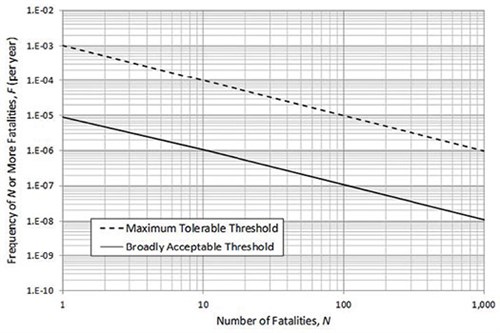
FIG. 4. CSA Z662:23 proposed societal risk acceptance criteria. - Guidance on environmental risk acceptance criteria:
- The broadly acceptable environmental risk threshold is 2.4 × 10–2 m3/km-yr, and the maximum tolerable risk threshold is 2.4 m3/km-yr (the impact-adjusted release volume). The impact-adjusted release volume is estimated with due consideration of factors, including failure mode and associate pipe opening, pipeline diameter, flowrate, product properties, sectionalizing valve spacing, release detection, isolation time and environmental impact based on location.
With respect to the broadly acceptable and maximum tolerable risk thresholds noted in the above criteria, the region between these two thresholds is considered tolerable risk if it can be demonstrated to be as low as reasonably practicable (ALARP), as shown in FIG. 5. The triangle represents the decreasing risk and the diminishing proportional benefit as risk is reduced.
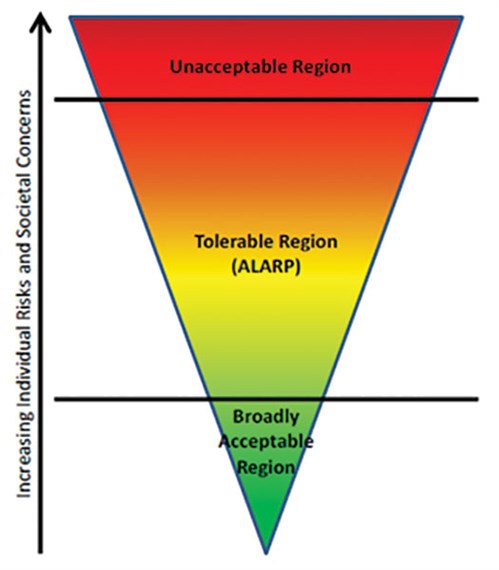 |
| FIG. 5. The ALARP concept. |
Demonstration of ALARP requires that the cost of further risk reduction is grossly disproportionate to the risk reduction achieved. So, with respect to risk acceptance thresholds, if it can be demonstrated that the risk levels satisfy broadly acceptable or ALARP requirements, a compelling case for pipeline safety can potentially be made in the context of a pipeline engineering assessment. The application of risk acceptance criteria, such as those proposed for the CSA Z662:23 standard, provides a strategic framework for improving pipeline safety and the use of risk assessment within an engineering assessment.
Quantitative risk acceptance criteria are also of interest to the U.S. regulatory bodies, and have also been explored through recent PHMSA industry studies and work groups related to quantitative risk modeling and risk tolerance thresholds. Independent risk and reliability-based safety cases are increasingly being requested as an important element of engineering assessments by U.S. regulatory bodies.
Data integration. Accurate data underlies the successful implementation of engineering assessments. This includes all pipe material attributes, construction, inspection and operating data necessary for the engineering assessment/fitness-for-service frameworks for all relevant threats and conditions.
Creating data integration roadmaps for each technical building block and aggregating these on a pipeline system basis yields a vision of the required data flows to support an effective engineering assessment. This vision includes being able to extrapolate learnings across sampling populations and pipeline systems, and across the industry in data warehousing approaches. Data integration requirements would be documented in standard operating procedures and fully integrated into an operator’s business management infrastructure (such as a geographic information system, a warehouse management system and/or data management software). The current focus on and requirements for materials verification and traceable, verifiable and complete records align with these data needs. Minimizing the use of default values ensures that a risk-prioritized focus is not distorted.
Integrity data collected from continuously evolving and improving ILI technologies will increasingly act as a key foundation for engineering assessments, including ILI tools for metal loss, cracking, mechanical damage and specific conditions (i.e., hard spots, long seam flaws and pipe movement). Therefore, it is important that the objectives are clearly defined, and that the correct ILI technology is applied for assessing the applicable threats. This includes consideration of the detection and sizing capabilities. For example, the newer-generation electromagnetic acoustic transducer (EMAT) ILI technology has evolved significantly to a point where it can play a primary role in stress corrosion cracking assessment and management programs for gas transmission pipelines. The National Association of Corrosion Engineers (NACE) International SP0102 standard,4 as referenced in the American Petroleum Institute (API) 1163 standard,5 provides guidance on proper tool selection by threat, as shown by the excerpt in FIG. 6.
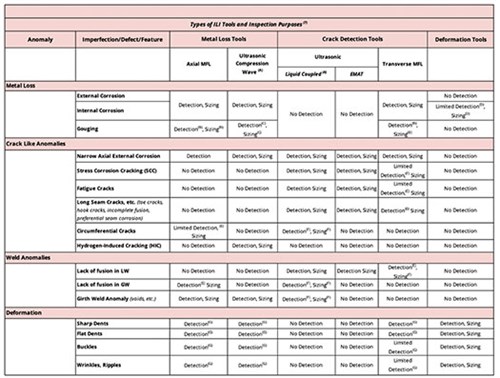 |
| FIG. 6. Excerpt from ILI System Selection Guidance in NACE SP0102. |
A documented verification and validation assessment of the ILI tool performance is a necessary foundation for using the ILI data as part of the engineering assessments. Also, qualification programs related to non-destructive evaluation tools used in the field for such validation also play a key role in ensuring that the ILI results are accurately validated.
Where ILI data serves as a foundation for the engineering assessment, it should not be taken for granted that all stakeholders are familiar with, or accepting of, the ILI technology applied (particularly for less-established technologies). A full API 1163-based analysis, including the tool selection against the objective, the run verification (i.e., data quality assessment, run functionality checks) and the tool performance validation (i.e., unity plots of tool vs. infield measurements) should be included. There should also be workflows and analysis steps to deal with outliers in tool performance. There must be pathways for investigation and root cause analysis for outliers, and, where necessary, opportunities to reject the inspection where outliers or significant data degradation gaps cannot be resolved.
Part 2. Part 2 will be published on www.GasProcessingNews.com. GP
NOTES
This article was first presented at the 34th Pipeline Pigging & Integrity Management Conference, February 2022.
a On October 1, 2019, the PHMSA finalized a rule for gas transmission pipelines that had been in development for more than 8 yr. The effective date is designated as July 1, 2020. This highly anticipated rule (referred to as the Gas Mega Rule) is the most significant change to existing gas pipeline regulations since 1970 and is likely to have a significant impact on the operation of gas transmission assets in the U.S. The rule is split into three parts, generally focusing on MAOP reconfirmation, material verification and integrity assessments outside of HCAs (Part 1); improvements to repair and response criteria and to the integrated master plan (IMP) (Part 2, still anticipated); and gas gathering (Part 3, released in November 2021).
LITERATURE CITED
- Canadian Standards Association (CSA), “CSA Z662:19 Standard: Oil and Gas Pipeline Systems,” CSA, 2019.
- Flamberg, S., S. Rose, B. Kurth and C. Sallaberry, “Paper study on risk tolerance,” PHMSA, June 30, 2016, online: https://primis.phmsa.dot.gov/matrix/FilGet.rdm?fil=10733
- U.S. Code of Federal Regulations, “Part 192—Transportation of natural and other gas by pipeline: Minimum federal safety standards,” amended March 17, 2022.
- National Association of Corrosion Engineers International (NACE International), “SP0102-2017: In-Line Inspection of Pipelines,” 2017.
- American Petroleum Institute (API), “Standard 1163: In-Line Inspection Systems Qualifications,” 2nd ed., April 2013, reaffirmed August 2018.
 |
BEN MITTELSTADT is Director of Technical Services at Dynamic Risk Assessment Systems Inc., in Houston, Texas. He has 20 yr of experience related to engineering, project management, and in the operation and integrity management of pipelines. He spent his first 12 yr with pipeline operators before becoming a consultant. He has developed and supported the execution of all aspects of integrity management plans, and has extensive experience with integrity assessment methods, including ILI and hydrostatic testing. As a registered Professional Engineer in the states of Texas and Massachusetts, Mr. Mittelstadt has served as a senior-level integrity engineer and manager of risk management for two major pipeline operators, and has led, or provided support to, a wide array of projects over his career, including root cause investigations, IMP development and execution, integrity assessments, pipeline failure responses, regulatory audits, review and development of standards and procedures, and the development of risk-based mitigation programs. He earned a BS degree in mechanical engineering from Colorado State University.
 |
DAN WILLIAMS is a Principal Consultant at Dynamic Risk Assessment Systems Inc., in Calgary, Alberta, Canada, where he is responsible for providing technical leadership in pipeline engineering assessment and risk management services. He has more than 30 yr of experience in pipe manufacturing and pipeline integrity. His work includes providing subject matter expert (SME) guidance on the development of pipeline risk models (leveraging ILI, direct assessment and GIS inputs), conducting threat-based engineering assessments, evaluating pipeline risks, and reporting on pipeline risk results as actionable risk reports that can support effective decision-making for clients in Canada and the U.S. He is a licensed Professional Engineer with a BE.Sc degree in materials engineering from Western University in Canada.




Comments